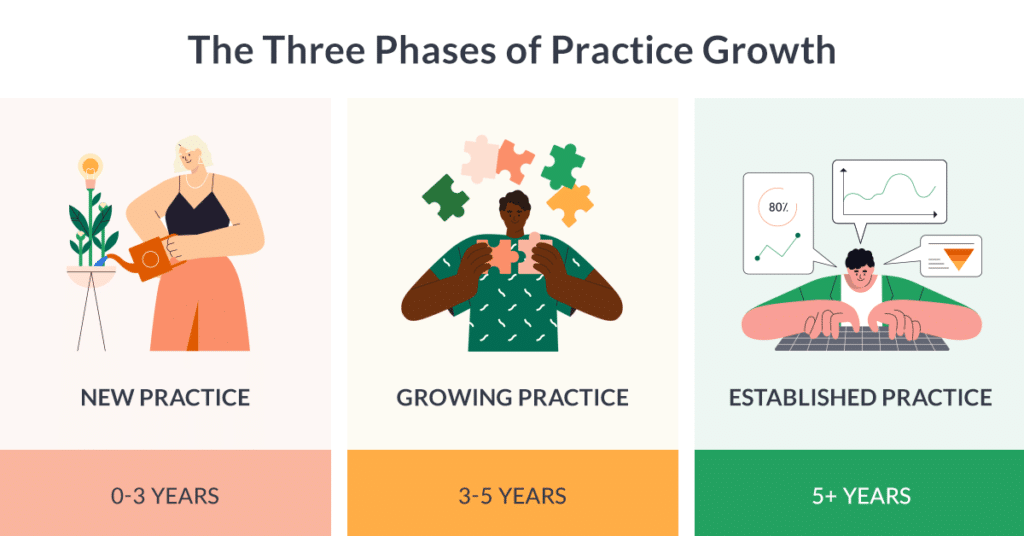
Everyone starts their business with the idea that it will become a huge success. Nobody starts a business thinking it will hit a plateau or slide backwards over time. Unfortunately, many businesses do just that.
In the dental industry, this pattern of unsteady growth is common. Even though there’s a constant need for dental treatment, that doesn’t mean all dental practices will see consistent success.
That’s where the three phases of growth come into play. Some dental practices may not get past phase one, while some grow and evolve consistently until they are profitable and self-sufficient. Each growth phase has specific characteristics and priorities that the owner should focus on to achieve success and stability.
The Three Phases of Growth
As a rule, every dentist who runs a practice will go through three phases of growth on their way to building a successful business. They are:

New Practice (0-3 years)
- Focused on survival and getting to profitability
- Main priority is building a strong patient base
- Typically a solo dentist/clinician doing all treatment and recalls
- Spending more money on advertising and marketing to gain new patients
- Team members are still learning to work together
- Systems are new and still being tested
- New patient growth and patient retention are equally important
The first few years of a dental practice should be focused on growth and developing systems to support that growth. There is so much more to do than simply taking care of the patient’s clinical needs. You are likely to invest more money and time into the business than you’d like to, but that investment will pay off as you build up a consistent and strong foundation. Perhaps the most crucial aspect in the early days is to focus on patient retention.
Keep a strong focus on growth and building systems early on, and you will feel the stress starting to lower as you gain ground.

Growing Practice (3-5 years)
- Focused on profitability and stability
- Have an active patient base of more than 1,000 patients
- Typically 1-2 dentists and one hygienist
- Developing a specialty in the practice
- Team and systems are working but still ironing out some inefficiencies
- Using basic metrics to track results and keep business on track
- Owner is busy running the business day-to-day
Any business owner should ideally have the goal of working less and earning more. As your practice begins to grow consistently, your focus can shift to creating stability so you can step back.
In this phase, typically between the 3rd and 5th year, you can solidify your systems and step back a little. Once you have a base of 1,000 or more active patients, you know that you can hand over the day-to-day clinical work to your team. This is a great opportunity to focus on a clinical specialty that has higher profit potential, like implantology or endodontics. You might also look at expanding your roster of clinicians to start gaining some financial leverage.

Established Practice (5 years or more)
- Focused on leveraged income and high profitability
- Active patient based of 1,800 patients per dentist or more
- 1-2 hygienists per dentist
- Team members are well-trained
- Systems are effective and efficient
- Using metrics to track leveraged growth
- Owner works on improving the business rather than working as a clinician
After more than five years of running your practice, you should ideally be moving into the established phase. This phase is when you have a skilled team, clear systems, and know your numbers.
Most importantly, an owner of an established practice should be doing less work and letting the business run itself. They may still practice a few days a week, but the overall focus should be on letting others do the work and measuring the results. An established practice is one that runs smoothly, consistently, and is very much self-sustained—generating profit without direct effort from the practice owner. If you’re interested in expansion, this is your chance to explore some opportunities.
Put your knowledge into action
Once you know which phase of growth your practice is currently in, you can gain clarity around your situation and potential. Rather than comparing your team to other practices at a different phase, set new benchmarks for success that are specific to your practice and situation. It will reduce the stress on your team and give you a better chance to grow at your own pace.
This knowledge should give you the confidence to understand where your team’s energy should be focused and take better control of your dental practice’s future.
FREE RESOURCE
The Three Phases of Practice Growth
A dental practice's lifecycle journey




